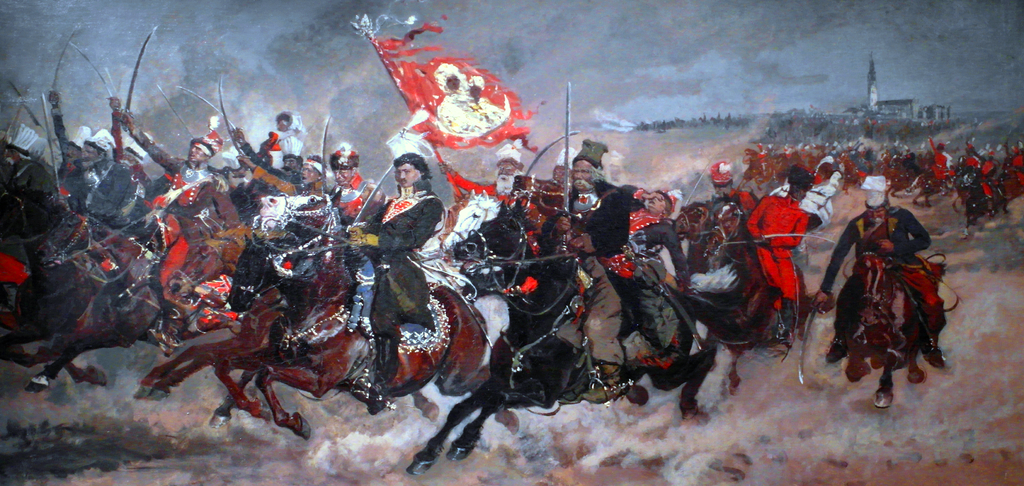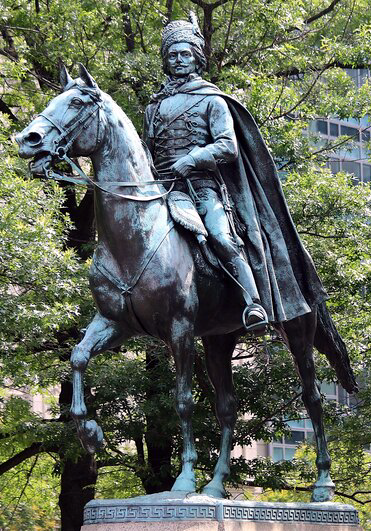Archive for March 1st, 2021
2021 DYKP CONTEST EXTENDED and CASIMIR PULASKI DAY
DYKP contest extended through
March 28th, 2021
░D░o░░y░o░u░ ░k░n░o░w░
░P░O░L░A░N░D░?░
The contest challenges all to give their knowledge of Polish heritage a test by identifying images on the new cover of the “Do You Know Poland?” booklet.
► download the booklet here ◄
More information about the contest
and detailed submission rules are
► available for download here ◄
along with a reprint of PAC_WI President’s introduction of the contest
in the national PAC newsletter.
CASIMIR PULASKI DAY
First Monday of March
in Wisconsin and Illinois
The memory of General Casimir Pulaski (pl: Generał Kazimierz Pułaski), a national hero of the United States and Poland, is celebrated in different parts of America on various dates throughout the year.
The federal observance of General Pulaski Memorial Day was established in 1929 by the joint resolution of Congress to take place on October 11th (the day of Pulaski’s death during the siege of Savannah in 1779). Since that year, every President of the United States has annually issued a related proclamation (1930 was the only exception). For Polish Americans living on the East Coast, the magnificent Pulaski Day Parade on Fifth Avenue in New York City is the highlight of related celebrations, coinciding with the Polish Heritage Month. With an exception of 1942 and 2020, the parade took place every year since 1937.
A smaller, yet equally vibrant and filled with Polish pride, parade is held in Bufallo, NY on Pulaski Day observed in mid-July. But the string of Pulaski events begins every year in Wisconsin and Illinois with the Casimir Pulaski Day observed on the first Monday of March in memory of Pulaski’s birthday in 1745. The laws establishing this commemoration were enacted in 1977 (Illinois) and 1987 (Wisconsin). In 2021, March 1st was the exact date of the Casimir Pulaski Day and on this occasion, the story featured below is certain to help us reflect on and revere Pulaski’s life and achievements.
RECALLING A GREAT
POLISH AND AMERICAN PATRIOT
October 11, 2020 marks the 241 th Anniversary of the death of General Kazimierz Pulaski, best known in America as Casimir Pulaski.
Pulaski was born on March 4, 1747 in Warka, Poland into a staunchly patriotic, gentry family. Having completed his education in legal and military studies he became engaged in 1768 in a patriotic movement created in the eastern Polish town of Bar, a movement that became known as the Confederation of Bar. The movement aimed at reversing Poland’s long slide into subservience to imperial Russia
 Kazimierz Pułaski at Częstochowa during Bar Confederation, painting by Józef Chełmoński (1849-1914) Public domain via Wikipedia Commons
Kazimierz Pułaski at Częstochowa during Bar Confederation, painting by Józef Chełmoński (1849-1914) Public domain via Wikipedia Commons
Between 1768 and 1772, Pulaski distinguished himself in a series of cavalry battles against the Russian army that entered his unhappy land to put down the revolt. In 1771 he heroically defended Czestochowa from an attack by a much larger Russian force. His victory there is immortalized in Jozef Chelmonski’s painting, “Pulaski at Czestochowa.” But when Russia crushed the Confederation, Pulaski was forced into exile, first in Turkey then in France.
In France, Pulaski learned of the American colonies’ declaration of independence. Making his way to Paris, he met Benjamin Franklin, the emissary to France of the newly formed American government. There he volunteered his services to the independence cause. Franklin was much impressed by Pulaski; in his letter introducing him to his compatriots in America he described Pulaski as “an officer famous throughout Europe for his bravery and conduct in defense of the liberties of his country.”
Following his arrival in America, Pulaski was given a commission as a cavalry officer by the Continental Congress. Not long after, he played a key role at the battle of Brandywine in leading his men in protecting General George Washington’s forces from being overtaken and possibly destroyed by the British army. His actions won his promotion to the rank of Brigadier General with the responsibility of organizing all mounted troops in the land. Thus, he is rightly recognized as the “father of the American Cavalry.”
Later, Pulaski organized and financed his own legion, a force of 268 men, which fought with great courage and success for the independence cause. The banner flown by his men in battle became famous and was remembered years later in Henry Wadsworth Longfellow’s stirring poem, “The Hymn of the Moravian Nuns.”
 Kazimierz Pułaski statue in Washington D.C.
Kazimierz Pułaski statue in Washington D.C.
Public domain via Wikipedia Commons
Sent south to the Carolinas, Pulaski’s legion successfully defended Charlestown from the British. He and his men then took part in a French-American attack aimed at recapturing the town of Savannah, Georgia.
There on October 11, 1779 Pulaski was mortally wounded leading his men in a charge on the British entrenchments. His death was mourned throughout the colonies. Indeed, the Continental Congress approved a resolution to erect a monument in honor of his devotion to the American independence cause.
Over a century later, a monument to him was erected and at the government’s expense in Washington, D.C. It was dedicated by the President of the United States, William Howard Taft, on May 11, 1910, along with a second monument to his countryman and fellow patriot, Tadeusz Kosciuszko. (That monument was funded by the Polish National Alliance as a “gift to the American people.”)
Indeed, there are scores of other memorials to Pulaski. They include Fort Pulaski near Savannah. Pulaski monuments are in five states. And six counties and twenty towns are named after Pulaski, as are a number of streets, including Pulaski Road in Chicago.
In 1929, the 150th anniversary of his death, President Herbert Hoover proclaimed Pulaski Day as a Day of Observance throughout the country. On November 6, 2009 President Barack Obama signed legislation approved by Congress making Pulaski a citizen of the United States. (March 4, the day of Pulaski’s birth, is also formally recognized in the states of Illinois and Wisconsin.)
For many years Pulaski’s remains were believed to have been placed aboard an American warship after the battle and buried at sea. But thanks to the research of Polonia activist Edward Pinkowski, it has been shown that Pulaski’s remains lie under the monument in his honor in Savannah.
The remarkable Kazimierz Pulaski is remembered today as a dedicated fighter for freedom – both for his homeland and America – and one who gave his very life to the American independence cause. He, like his compatriot Tadeusz Kosciuszko, along with the famed Polish Constitution of the May the Third, 1791, have come to symbolize the unbreakable solidarity of values that unite the freedom loving peoples of Poland and the United States of America.
Donald Pienkos with thanks to Drs Francis Kajencki of Texas and Angela Pienkos of Wisconsin for their research on Pulaski.
Archived Posts
- 2023 Merry Christmas
- 2023 Lighting the Light of Freedom on Dec 13 at 7:30pm
- Independence Day and Veteran Day invitation
- 2023 Wianki Festival
- 2023 May 3rd Constitution Day Celebration
- 2023 Lecture on Polish Borders by Prof. Don Pienkos
- 2023 REMEMBER THIS: Jan Karski movie premieres on PBS Wisconsin
- 2023 Upcoming lectures in the Polish Center of Wisconsin
- 2022 Polish National Independence Day
- 2022 Independence and Veteran Day Luncheon (invitation)
- 2022 Wianki, Polish Celebration of Noc Świętojańska (St. John’s Night)
- Celebrating Constitution of May 3, 1791 in Polish Center of Wisconsin
- 2022 Polish Constitution Day, Polish Flag Day and the Day of Polonia
- 2022 March Bulletin
- 2022 Polonia For Ukraine Donations
- 2022 Polish American Congress Condemns Russian Invasion of Ukraine
- 2022 PAC-WI State Division Letters to WI Senators and Representatives
- 2021 Polish Christmas Carols
- 2021 Panel Discussion: Martial Law in Poland 1981-1983 (REPORT)
- 2021 Panel Discussion: Martial Law. Poland 1981-1983 (invitation)
- 2021 Solidarity: Underground Publishing and Martial Law 1981-1983
- 2021 Polish Independence Day and Veterans Day
- 2021 Polish Independence Day and Veterans Day Luncheon
- 2021 Prof. Pienkos lecture: Polish Vote in US Presidential Elections
- 2021 POLISH HERITAGE MONTH EVENTS
- 2021 “Freedom” Monument Unveiled in Stevens Point, Wisconsin
- 2021 PCW Picnic and Fair
- 2021 Remembering Września Children Strikes (1901-1903)
- 2021 May 3 Constitution Day
- 2021 DYKP Contest Winners and Answers
- 2021 DYKP CONTEST EXTENDED and CASIMIR PULASKI DAY
- 2021 February announcements
- 2021 Polish Ministry of Education and Science oficials visit Wisconsin
- 2021 DYKP Contest, KF Gallery and Dr. Pease lectures
- 2020 Help Enact Resolution commemorating the 80th Anniversary of the Katyn Massacre
- 2020 Independence And Veterans Day
- 2020 Remembering Paderewski
- 2020 POLISH HERITAGE MONTH
- 2020 Solidarity born 40 years ago
- 2020 Battle of Warsaw Centenary
- 2020 The Warsaw Rising Remembrance
- 2020 June/July News: Polish Elections, Polish Films Online and more
- 2020 Poland: Virtual Tours
- Centennial of John Paul II’s Birth
- 2020 Celebrating Polish Flag, Polonia and Constitution of May 3rd
- 2020 Polish Easter Traditions
- 2020 Census and Annual Election
- Flavor of Poland (Update 3)
- 2020 Copernicus, Banach & Enigma talk
- 2020 Do You Know Poland and other announcements
- 2020 Flavor of Poland (Update 2)
- 2020 People and Events of the Year
- 2019 Holidays
- 2019 December Medley
- 2019 Independence Celebration
- 2019 Independence Invitation
- 2019 WI Study in Poland Reports
- Lecture: Poland’s Entry Into the NATO
- August 2019 anniversaries
- 2019 Polish Fest
- Celebrating Polish Constitution and Ignacy Paderewski
- WSIP 2018 Reports (Wisconsin Study in Poland)
- 2018 Christmas Carols
- 2018 Polish Independence and Veterans Day
- November 2018 events
- October 2018 Events
- 2018 Kashube Lecture Notes
- September 2018 events
- 2018 Polish Fest Report
- Upcoming 2018 Polish Fest
- Celebrating Polish Constitution Day
- Poland 1979-1989 (panel discussion)
- Protest the Passage of S.447 in the U.S. House of Representatives



